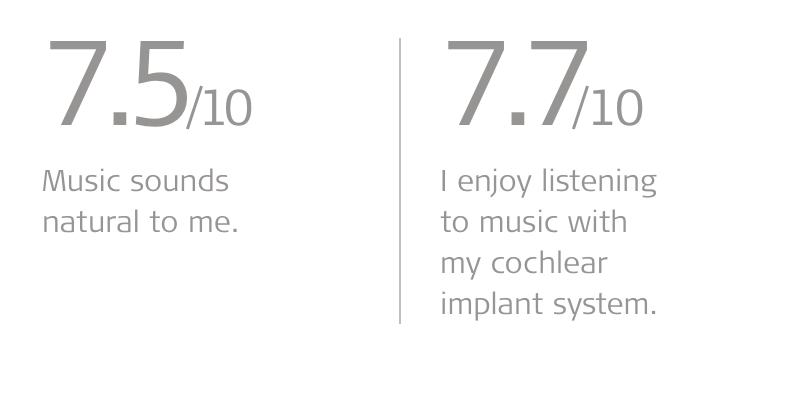MED-EL
Published Sep 16, 2021
The Importance of Music in Cochlear Implant Rehabilitation for Adults

Music promotes social connectedness and well-being.[6] It plays an important part in people’s lives and remains an important factor in the lives of cochlear implant (CI) recipients.[4] “Music contributes to positive aging by providing ways for people to maintain positive self-esteem, feel competent, independent, and avoid feelings of isolation and loneliness,” and it can be harnessed by professionals to facilitate and improve well-being in older adults.[6]
A Close Relationship: The Neural Processing of Music & Speech in the Brain
In normal hearing individuals, neuroimaging has shown a close relationship between the neural processing of music, speech, and language.[8] These findings have been supported by other research which suggests that music training may benefit music and speech perception, and speech perception in noise by facilitating underlying functions such as auditory working memory, auditory attention, pitch and duration perception.[3,7,10,11] In addition, older musicians demonstrated enhanced speech-in-noise perception and greater auditory working memory capacity compared to non-musicians. [10,11]
In cochlear implant recipients, the emotional rewards of music, the focused attention and repetition music training requires, along with the high demands that music training places on the sensory and cognitive processing mechanisms shared by music and speech, may cause lasting changes in brain structure and function which then enhance speech processing.[12]
The Case for Including Music in Cochlear Implant Rehabilitation
While the primary aim of cochlear implant rehabilitation has always been to promote the perception of speech, increasingly, activities that target music perception and appreciation have also become part of cochlear implant rehabilitation.[9] In a systematic review evaluating the efficacy of music training on music perception among individuals fitted with hearing devices, it was found that significant improvements in musical perception were achieved.[13] Similarly, in a small group of postlingually deafened adult cochlear implant recipients with limited musical background, it was found that musical pattern perception and speech perception in quiet and in noise as well as music enjoyment was improved following music training.[14]
The Role of Technology in CI Recipients’ Music Perception and Appreciation
Cochlear implant recipients’ music appreciation and perception are likely also influenced by a range of cochlear implant factors, such as the coding strategy as well as patient specific factors.[1] At MED-EL, we use fine structure processing, or FineHearing, which is the only sound coding for cochlear implants that instantly adapts the stimulation rate for electrode contacts in the second turn to match the natural frequencies of the incoming sounds.
By combining long electrode arrays for accurate place coding with FineHearing for accurate rate coding, you can achieve a more accurate, more natural stimulation of the whole cochlea. And by providing the closest to natural stimulation of the cochlea, the closest to natural hearing experience with a cochlear implant is enabled.
For more info on FineHearing, you can listen to a short interview with Peter Nopp, Director of Signal Processing Research at MED-EL, in which he provides more insights into how FineHearing works and mimics natural sound coding.
So does FineHearing help cochlear implants when it comes to music appreciation and perception? Don’t take our word for it. We asked more than 100 MED-EL cochlear implant users to rate how much they agree with the following statements on a scale from 0/10 = “strongly disagree” to 10/10 = “strongly agree.” Their combined average answers are shown below.

More on the survey, along with interactive learning tools and a comprehensive explanation of cochlear implant sound quality and the benefits of more natural hearing, can be found on our page, “What Does a Cochlear Implant Sound Like?”.
Other Influences on Cochlear Implant Recipients’ Music Perception and Appreciation
In addition to factors related to cochlear implant processing, attention, expectations of music perception outcomes and motivation to practice are all factors which may influence music enjoyment in cochlear implant recipients.[2] Cochlear implant recipients may enhance their music appreciation by controlling their listening environment, using good quality equipment and direct audio input, and adding visual information, such as watching the performer or following along with lyrics.[5]
Listening to familiar, and less complex music may also support cochlear implant recipients’ perception and enjoyment of music.[5] Rehabilitation which manages expectations and includes music training with activities focused on pitch, timbre, and pattern perception, as well as melody recognition may support music appreciation in cochlear implant recipients.[14, 13]
Music in Cochlear Implant Rehabilitation & Supporting Adults Remotely
For more about training with music in cochlear implant rehabilitation, watch Johanna Boyer and Christine Rocca share their expertise and practical experience at our recent ExpertsONLINE webinar.
MED-EL Cochlear Implants: The Closest to Natural Hearing
For more on how MED-EL’s cochlear implants have been designed for natural hearing, check out our page on what cochlear implants sound like.
To support you to offer effective rehabilitation sessions to cochlear implant recipients in adulthood, we also provide free adult rehabilitation kits.
Subscribe & Share
Know someone who might benefit from this article? Help them out by sharing the link with them.
Also make sure you’ve subscribed so you don’t miss any of our future articles or free rehabilitation kits.
References
[1] Arnoldner, C., Riss, D., Brunner, M., Durisin, M., Baumgartner, W., & Hamzavi, >. (2007). Speech and music perception with the new fine structure speech coding strategy: preliminary results. Acta Oto-Laryngologica, 127(12), 1298-1303. https://doi.org/10.1080/00016480701275261
[2] Bartel, L., Greenberg, S., Friesen, L., Ostroff, J., Bodmer, D., Shipp, D., & Chen, J. (2011). Qualitative case studies of five cochlear implant recipients’ experience with music. Cochlear Implants International, 12(1), 27-33. https://doi.org/10.1179/146701010×486435
[3] Besson, M., Chobert, J., & Marie, C. (2011). Transfer of Training between Music and Speech: Common Processing, Attention, and Memory. Frontiers In Psychology, 2. https://doi.org/10.3389/fpsyg.2011.00094
[4] Frederigue-Lopes, N., Bevilacqua, M., & Costa, O. (2015). Munich Music Questionnaire: Adaptation Into Brazilian Portuguese and Application in Cochlear Implant Users. CoDAS. 27, 13-20. http://dx.doi.org/10.1590/2317-1782/20152013062
[5] Looi, V., Gfeller, K., & Driscoll, V. (2012). Music Appreciation and Training for Cochlear Implant Recipients: A Review. Seminars In Hearing, 33(04), 307-334. https://doi.org/10.1055/s-0032-1329222
[6] Hays, T., & Minichiello, V. (2005). The meaning of music in the lives of older people: a qualitative study. Psychology Of Music, 33(4), 437-451. https://doi.org/10.1177/0305735605056160
[7] Kraus, N., Strait, D., & Parbery-Clark, A. (2012). Cognitive factors shape brain networks for auditory skills: spotlight on auditory working memory. Annals Of The New York Academy Of Sciences, 1252(1), 100-107. https://doi.org/10.1111/j.1749-6632.2012.06463.x
[8] Limb, C. (2006). Structural and functional neural correlates of music perception. The Anatomical Record Part A: Discoveries In Molecular, Cellular, And Evolutionary Biology, 288A(4), 435-446. https://doi.org/10.1002/ar.a.20316
[9] Näätänen, R., Petersen, B., Torppa, R., Lonka, E., & Vuust, P. (2017). The MMN as a viable and objective marker of auditory development in CI users. Hearing Research, 353, 57-75. https://doi.org/10.1016/j.heares.2017.07.007
[10] Parbery-Clark, A., Strait, D., & Kraus, N. (2011). Context-dependent encoding in the auditory brainstem subserves enhanced speech-in-noise perception in musicians. Neuropsychologia, 49(12), 3338-3345. https://doi.org/10.1016/j.neuropsychologia.2011.08.007
[11] Parbery-Clark, A., Strait, D., Anderson, S., Hittner, E., & Kraus, N. (2011). Musical Experience and the Aging Auditory System: Implications for Cognitive Abilities and Hearing Speech in Noise. Plos ONE, 6(5), e18082. https://doi.org/10.1371/journal.pone.0018082
[12] Patel, A. (2014). Can nonlinguistic musical training change the way the brain processes speech? The expanded OPERA hypothesis. Hearing Research, 308, 98-108. https://doi.org/10.1016/j.heares.2013.08.011
[13] Shukor, N., Lee, J., Seo, Y., & Han, W. (2021). Efficacy of Music Training in Hearing Aid and Cochlear Implant Users: A Systematic Review and Meta-Analysis. Clinical And Experimental Otorhinolaryngology, 14(1), 15-28. https://doi.org/10.21053/ceo.2020.00101
[14] Smith, L., Bartel, L., Joglekar, S., & Chen, J. (2017). Musical Rehabilitation in Adult Cochlear Implant Recipients With a Self-administered Software. Otology & Neurotology, 38(8), e262-e267. https://doi.org/10.1097/mao.0000000000001447
MED-EL
Was this article helpful?
Thanks for your feedback.
Sign up for newsletter below for more.
Thanks for your feedback.
Please leave your message below.
CTA Form Success Message
Send us a message
Field is required
John Doe
Field is required
name@mail.com
Field is required
What do you think?
MED-EL



